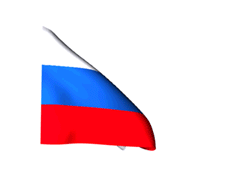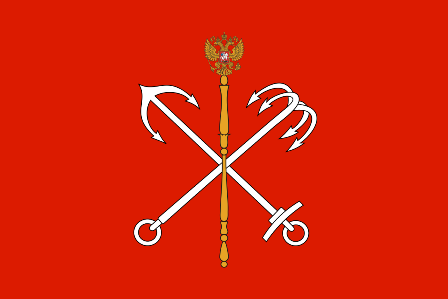
Russian flag is composed of three horizontal stripes of equal width. Red, blue and white are considered traditional Pan-Slavic colors and wide number of states adopted them in the 19th century since Russia was at that time the only independent Slavic state. During the rule of the Communist Party, the tricolor was replaced by the red flag with a hammer and a sickle in the upper left part of the flag. After the fall of the Soviet Union in 1991, Kremlin decided to return to traditional tricolor. There are many theories explaining the symbolism of the tricolor. White can represent the aristocracy, Belarusians, God, peace, purity, or honesty; blue Ukrainians, tsar, persistence, or faith and fortitude; red can stand for Russians, people, power, or blood shed for the country.
 The flag of Saint Petersburg, in the Russian Federation, is a red field charged in the centre with the arms of the city, which consists of two silver anchors (a sea anchor, and a river anchor), and a gold scepter. The anchors both cross each other at their centers, with the sea anchor to the left and the river anchor on the right. They reflect the fact that the city has both river and sea ports. The scepter is surmounted on the anchors in the centre. It shows that the city was the former capital of Russia. The flag was adopted on 6 September 1991.
The flag of Saint Petersburg, in the Russian Federation, is a red field charged in the centre with the arms of the city, which consists of two silver anchors (a sea anchor, and a river anchor), and a gold scepter. The anchors both cross each other at their centers, with the sea anchor to the left and the river anchor on the right. They reflect the fact that the city has both river and sea ports. The scepter is surmounted on the anchors in the centre. It shows that the city was the former capital of Russia. The flag was adopted on 6 September 1991.
To return to the main listing of the cruise hyperlinks click here


 The flag of Saint Petersburg, in the Russian Federation, is a red field charged in the centre with the arms of the city, which consists of two silver anchors (a sea anchor, and a river anchor), and a gold scepter. The anchors both cross each other at their centers, with the sea anchor to the left and the river anchor on the right. They reflect the fact that the city has both river and sea ports. The scepter is surmounted on the anchors in the centre. It shows that the city was the former capital of Russia. The flag was adopted on 6 September 1991.
The flag of Saint Petersburg, in the Russian Federation, is a red field charged in the centre with the arms of the city, which consists of two silver anchors (a sea anchor, and a river anchor), and a gold scepter. The anchors both cross each other at their centers, with the sea anchor to the left and the river anchor on the right. They reflect the fact that the city has both river and sea ports. The scepter is surmounted on the anchors in the centre. It shows that the city was the former capital of Russia. The flag was adopted on 6 September 1991.